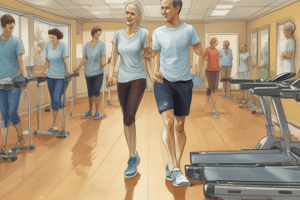Podcast
Questions and Answers
What is the definition of stride length in one gait cycle?
What is the definition of stride length in one gait cycle?
- Distance from heel strike of one foot to heel strike of the same foot (correct)
- Distance from heel strike of one foot to heel strike of the other foot
- Distance from heel strike of one foot to the midline of the other foot
- Distance between the midline of one foot at mid-stance and the midline of the other foot at mid-stance
What is the normal cadence of walking?
What is the normal cadence of walking?
- 100-110 steps/min
- 80-100 steps/min
- 107 steps/min (correct)
- 120-130 steps/min
What is the definition of step length in one gait cycle?
What is the definition of step length in one gait cycle?
- Distance between successive points of contact of the opposite feet
- Distance from heel strike of one foot to heel strike of the same foot
- Distance from heel strike of one foot to heel strike of the other foot (correct)
- Distance between the midline of one foot at mid-stance and the midline of the other foot at mid-stance
What is the normal step or stride length?
What is the normal step or stride length?
What is the range of hip flexion required for normal gait?
What is the range of hip flexion required for normal gait?
Which phase is absent in running?
Which phase is absent in running?
What is the primary purpose of gait analysis?
What is the primary purpose of gait analysis?
What is the first priority of normal gait?
What is the first priority of normal gait?
What percentage of the gait cycle is the swing phase?
What percentage of the gait cycle is the swing phase?
What is one factor that can affect gait?
What is one factor that can affect gait?
What happens during heel strike?
What happens during heel strike?
What happens during the loading response phase?
What happens during the loading response phase?
Where is double limb support seen?
Where is double limb support seen?
How is the swing phase divided?
How is the swing phase divided?
Flashcards are hidden until you start studying
Study Notes
Gait Analysis Definition
- Gait analysis is a series of rhythmical and alternating movements of the trunk and limbs that result in forward progression of the Center of Gravity (COG) and the body.
Priorities of Normal Gait
- Stability of the weight-bearing foot throughout the stance period.
- Clearance of the non-weight-bearing foot during the swing period.
- Appropriate pre-positioning of the foot for the next gait cycle.
- Adequate step length.
- Energy conservation.
Elements of Gait Analysis
- Limb position.
- Range of Motion (ROM).
- Speed of Motion.
- Force Production.
- Timing of each event in the gait cycle.
Phases of Gait Cycle
- Stance Phase (~60% of cycle).
- Swing Phase (~40% of cycle).
Factors Affecting Gait
- Muscle strength.
- Body type.
- Gender.
- Joint ROM.
- Incline of surface.
- Surface type.
- Footwear.
Stance Phase
- Occurs when the foot is in contact with the floor and the extremity is bearing partial or total body weight.
- Double limb support is seen during the last 10% of the stance phase.
Heel Strike
- Foot: Supinated at subtalar.
- Ankle: Dorsiflexed.
- Knee: Flexed.
- Hip: Flexed.
Loading Response
- Limb reacts to absorbing the impact of body weight by initiating flattening of the foot.
- Talocrural joint: Plantarflexion.
- Subtalar joint: Pronation.
- Calcaneal eversion.
- Tibial internal rotation.
- Tibialis post: Eccentric contraction (decreases rate of deceleration of pronation).
- Tibialis ant: Eccentric contraction (decreases rate of plantarflexion).
- Hip maintains flexed position.
Swing Phase
- Divided into three phases: Early/Initial Phase, Mid Phase, and Late/Terminal Phase.
Gait Parameters
- Stride Length: Distance from heel strike of one foot to heel strike of the same foot in one gait cycle.
- Step Length: Distance from heel strike of one foot to heel strike of the other foot in one gait cycle.
- Stride Width: Distance between the midline of one foot at mid-stance and the midline of the other foot at mid-stance.
Normal Gait Values
- Cadence: ~107 steps/min.
- Step or Stride Length: 75 cm.
- Speed of Walking: 90-120 steps/minute.
- ROM Requirements:
- Hip Flex: 0-30.
- Hip Ext: 0-10.
- Knee Flex: 0-60.
- Knee Ext: 0.
- Ankle DF: 0-10.
- Ankle PF: 0-20.
Studying That Suits You
Use AI to generate personalized quizzes and flashcards to suit your learning preferences.




